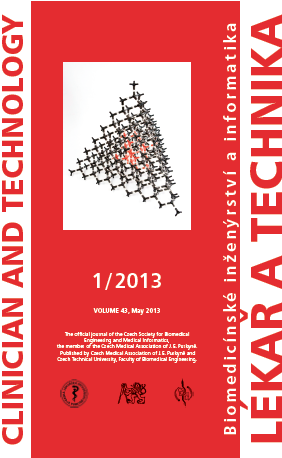SPECIFIC BEHAVIOUR OF THE BLOOD SEDIMENTATION PROCESSES EXAMINED BY THE ELECTROCHEMICAL IMPEDANCE MICROSENSOR
Keywords:
planar IDAE impedance microsensor, blood sedimentationAbstract
Electrochemical impedance microsensor for the fast monitoring of the blood sedimentation has been developed. Planar microsensor consisted of the interdigital array of electrodes (IDAE - finger/gap widths of different values from 5/5 μm to 400/400 μm) based on Au or Pt thin films sputtered on Si/SiO2 or ceramic alumina substrates. IDAE microsensor allows time measurements of electrical impedance changes - impedance rates - (at frequencies of order 0.1 kHz and 10 kHz) of small blood drop applied on it. The determination of the impedance rate during sedimentation and the impedance spectrometry at a low-frequency range of order of 1 kHz seems to be very helpful for a quick diagnostics of the health state. In the IDAE microsensor erythrocyte aggregation/rapid settling/packing periods associated with dryperiod are overlapping due to the planar arrangement of dimensions in order of 1-100 μm. The time monitoring of the blood sedimentation (in the range of 10-900 seconds) by the impedance method can distinguish between healthy and cancer state of blood and could serve for the simple long-term diagnostics after the surgical operation or as a screening procedure for early diagnoses.Downloads
Published
Issue
Section
License
Copyright (c) 2017 Štefan Durdík, Vladimír Tvarožek, Soňa Flickyngerová, Daniel Donoval

This work is licensed under a Creative Commons Attribution 4.0 International License.
Authors who publish with this journal agree to the following terms:
- Authors retain copyright and grant the journal right of the first publication with the work simultaneously licensed under a Creative Commons Attribution License (https://creativecommons.org/licenses/by/4.0/) that allows others to share the work with an acknowledgment of the work's authorship and initial publication in CTJ.
- Authors are able to enter into separate, additional contractual arrangements for the non-exclusive distribution of the journal’s published version of the work (e.g., post it to an institutional repository or publish it in a book), with an acknowledgment of its initial publication in this journal.
- Authors are permitted and encouraged to post their work online (e.g., in institutional repositories or on their website or ResearchGate) prior to and during the submission process, as it can lead to productive exchanges.
CTJ requires that all of the content of the manuscript has been created by its respective authors or that permission to use a copyrighted material has been obtained by the authors before submitting the manuscript to CTJ. CTJ requires that authors have not used any copyrighted material illegally, as for example a picture from another journal or book, a photo, etc. It is the author’s responsibility to use only materials not violating the copyright law. When in doubt, CTJ may ask the authors to supply the pertinent permission or agreement about the use of a copyrighted material.
The opinions expressed in CTJ articles are those of authors and do not necessarily reflect the views of the publishers or the Czech Society for Biomedical Engineering and Medical Informatics.


